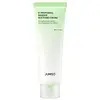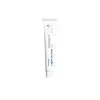What's inside
What's inside
 Key Ingredients
Key Ingredients

 Benefits
Benefits

 Concerns
Concerns

 Ingredients Side-by-side
Ingredients Side-by-side

Water
Skin ConditioningPropanediol
SolventGlycerin
HumectantPanthenol
Skin ConditioningButylene Glycol
HumectantCaprylic/Capric Triglyceride
MaskingSqualane
Emollient1,2-Hexanediol
Skin ConditioningCarbomer
Emulsion StabilisingArginine
MaskingCetearyl Olivate
Ethylhexylglycerin
Skin ConditioningSorbitan Olivate
EmulsifyingCetearyl Alcohol
EmollientAllantoin
Skin ConditioningBetaine
HumectantCeramide NP
Skin ConditioningHydrogenated Lecithin
EmulsifyingDipropylene Glycol
HumectantGlyceryl Stearate
EmollientHydroxypropyl Bislauramide Mea
EmollientMadecassoside
AntioxidantAsiaticoside
AntioxidantMadecassic Acid
Skin ConditioningAsiatic Acid
Skin ConditioningTocopherol
AntioxidantCholesterol
EmollientCeramide Ns
Skin ConditioningCeramide AP
Skin ConditioningCeramide As
Skin ConditioningPhenylalanine
MaskingLeucine
Skin ConditioningMethionine
Skin ConditioningLysine
Skin ConditioningHistidine
HumectantIsoleucine
Skin ConditioningValine
MaskingThreonine
Tryptophan
MaskingCeramide EOP
Skin ConditioningWater, Propanediol, Glycerin, Panthenol, Butylene Glycol, Caprylic/Capric Triglyceride, Squalane, 1,2-Hexanediol, Carbomer, Arginine, Cetearyl Olivate, Ethylhexylglycerin, Sorbitan Olivate, Cetearyl Alcohol, Allantoin, Betaine, Ceramide NP, Hydrogenated Lecithin, Dipropylene Glycol, Glyceryl Stearate, Hydroxypropyl Bislauramide Mea, Madecassoside, Asiaticoside, Madecassic Acid, Asiatic Acid, Tocopherol, Cholesterol, Ceramide Ns, Ceramide AP, Ceramide As, Phenylalanine, Leucine, Methionine, Lysine, Histidine, Isoleucine, Valine, Threonine, Tryptophan, Ceramide EOP
Water
Skin ConditioningCyclopentasiloxane
EmollientHydrogenated Poly(C6-14 Olefin)
EmollientGlycerin
HumectantPanthenol
Skin ConditioningDicaprylyl Carbonate
EmollientCaprylyl Methicone
Skin ConditioningCaprylic/Capric Triglyceride
MaskingPropanediol
SolventNiacinamide
SmoothingDimethicone
EmollientLauryl Polyglyceryl-3 Polydimethylsiloxyethyl Dimethicone
Skin Conditioning1,2-Hexanediol
Skin ConditioningDisteardimonium Hectorite
StabilisingC30-45 Alkyl Cetearyl Dimethicone Crosspolymer
EmollientSodium Chloride
MaskingSorbitan Sesquioleate
EmulsifyingSodium Citrate
BufferingEthylhexylglycerin
Skin ConditioningAllium Cepa Bulb Extract
Skin ConditioningRosa Damascena Callus Extracellular Vesicles
Skin ConditioningAdenosine
Skin ConditioningDipotassium Glycyrrhizate
HumectantButylene Glycol
HumectantHydrogenated Lecithin
EmulsifyingPolyglyceryl-10 Stearate
Skin ConditioningBeta-Glucan
Skin ConditioningSodium Ascorbyl Phosphate
AntioxidantTocopherol
AntioxidantTranexamic Acid
AstringentGlutathione
Bisabolol
MaskingAlpha-Arbutin
Antioxidant3-O-Ethyl Ascorbic Acid
Skin ConditioningPyridoxine
Skin ConditioningFolic Acid
Skin ConditioningBiotin
AntiseborrhoeicPentylene Glycol
Skin ConditioningCyanocobalamin
Skin ConditioningXanthan Gum
EmulsifyingCyamopsis Tetragonoloba Gum
Emulsion StabilisingFructooligosaccharides
HumectantPhytic Acid
Glucose
HumectantHydrolyzed Pea Protein
EmollientThiamine Hcl
MaskingRiboflavin
Cosmetic ColorantLinoleic Acid
CleansingBeta-Carotene
Skin ConditioningBioflavonoids
Skin ConditioningSodium Succinate
BufferingGlycoproteins
Skin ConditioningWater, Cyclopentasiloxane, Hydrogenated Poly(C6-14 Olefin), Glycerin, Panthenol, Dicaprylyl Carbonate, Caprylyl Methicone, Caprylic/Capric Triglyceride, Propanediol, Niacinamide, Dimethicone, Lauryl Polyglyceryl-3 Polydimethylsiloxyethyl Dimethicone, 1,2-Hexanediol, Disteardimonium Hectorite, C30-45 Alkyl Cetearyl Dimethicone Crosspolymer, Sodium Chloride, Sorbitan Sesquioleate, Sodium Citrate, Ethylhexylglycerin, Allium Cepa Bulb Extract, Rosa Damascena Callus Extracellular Vesicles, Adenosine, Dipotassium Glycyrrhizate, Butylene Glycol, Hydrogenated Lecithin, Polyglyceryl-10 Stearate, Beta-Glucan, Sodium Ascorbyl Phosphate, Tocopherol, Tranexamic Acid, Glutathione, Bisabolol, Alpha-Arbutin, 3-O-Ethyl Ascorbic Acid, Pyridoxine, Folic Acid, Biotin, Pentylene Glycol, Cyanocobalamin, Xanthan Gum, Cyamopsis Tetragonoloba Gum, Fructooligosaccharides, Phytic Acid, Glucose, Hydrolyzed Pea Protein, Thiamine Hcl, Riboflavin, Linoleic Acid, Beta-Carotene, Bioflavonoids, Sodium Succinate, Glycoproteins
 Reviews
Reviews

Ingredients Explained
These ingredients are found in both products.
Ingredients higher up in an ingredient list are typically present in a larger amount.
1,2-Hexanediol is a synthetic liquid and another multi-functional powerhouse.
It is a:
- Humectant, drawing moisture into the skin
- Emollient, helping to soften skin
- Solvent, dispersing and stabilizing formulas
- Preservative booster, enhancing the antimicrobial activity of other preservatives
Butylene Glycol (or BG) is used within cosmetic products for a few different reasons:
Overall, Butylene Glycol is a safe and well-rounded ingredient that works well with other ingredients.
Though this ingredient works well with most skin types, some people with sensitive skin may experience a reaction such as allergic rashes, closed comedones, or itchiness.
Learn more about Butylene GlycolThis ingredient is an emollient, solvent, and texture enhancer. It is considered a skin-softener by helping the skin prevent moisture loss.
It helps thicken a product's formula and makes it easier to spread by dissolving clumping compounds.
Caprylic Triglyceride is made by combining glycerin with coconut oil, forming a clear liquid.
While there is an assumption Caprylic Triglyceride can clog pores due to it being derived from coconut oil, there is no research supporting this.
Learn more about Caprylic/Capric TriglycerideEthylhexylglycerin (we can't pronounce this either) is commonly used as a preservative and skin softener. It is derived from glyceryl.
You might see Ethylhexylglycerin often paired with other preservatives such as phenoxyethanol. Ethylhexylglycerin has been found to increase the effectiveness of these other preservatives.
Glycerin is already naturally found in your skin. It helps moisturize and protect your skin.
A study from 2016 found glycerin to be more effective as a humectant than AHAs and hyaluronic acid.
As a humectant, it helps the skin stay hydrated by pulling moisture to your skin. The low molecular weight of glycerin allows it to pull moisture into the deeper layers of your skin.
Hydrated skin improves your skin barrier; Your skin barrier helps protect against irritants and bacteria.
Glycerin has also been found to have antimicrobial and antiviral properties. Due to these properties, glycerin is often used in wound and burn treatments.
In cosmetics, glycerin is usually derived from plants such as soybean or palm. However, it can also be sourced from animals, such as tallow or animal fat.
This ingredient is organic, colorless, odorless, and non-toxic.
Glycerin is the name for this ingredient in American English. British English uses Glycerol/Glycerine.
Learn more about GlycerinHydrogenated Lecithin is created from the hydrogenation of lecithin (a group of phospholipids). Hydrogenation is a chemical reaction between hydrogen and another element.
This ingredient is an emollient and emulsifier. As an emollient, it helps soften skin by trapping moisture within. As an emulsifier, it prevents oil and water ingredients from separating.
Panthenol is a common ingredient that helps hydrate and soothe the skin. It is found naturally in our skin and hair.
There are two forms of panthenol: D and L.
D-panthenol is also known as dexpanthenol. Most cosmetics use dexpanthenol or a mixture of D and L-panthenol.
Panthenol is famous due to its ability to go deeper into the skin's layers. Using this ingredient has numerous pros (and no cons):
Like hyaluronic acid, panthenol is a humectant. Humectants are able to bind and hold large amounts of water to keep skin hydrated.
This ingredient works well for wound healing. It works by increasing tissue in the wound and helps close open wounds.
Once oxidized, panthenol converts to pantothenic acid. Panthothenic acid is found in all living cells.
This ingredient is also referred to as pro-vitamin B5.
Learn more about PanthenolPropanediol is an all-star ingredient. It softens, hydrates, and smooths the skin.
It’s often used to:
Propanediol is not likely to cause sensitivity and considered safe to use. It is derived from corn or petroleum with a clear color and no scent.
Learn more about PropanediolTocopherol (also known as Vitamin E) is a common antioxidant used to help protect the skin from free-radicals and strengthen the skin barrier. It's also fat soluble - this means our skin is great at absorbing it.
Vitamin E also helps keep your natural skin lipids healthy. Your lipid skin barrier naturally consists of lipids, ceramides, and fatty acids. Vitamin E offers extra protection for your skin’s lipid barrier, keeping your skin healthy and nourished.
Another benefit is a bit of UV protection. Vitamin E helps reduce the damage caused by UVB rays. (It should not replace your sunscreen). Combining it with Vitamin C can decrease sunburned cells and hyperpigmentation after UV exposure.
You might have noticed Vitamin E + C often paired together. This is because it is great at stabilizing Vitamin C. Using the two together helps increase the effectiveness of both ingredients.
There are often claims that Vitamin E can reduce/prevent scarring, but these claims haven't been confirmed by scientific research.
Learn more about TocopherolWater. It's the most common cosmetic ingredient of all. You'll usually see it at the top of ingredient lists, meaning that it makes up the largest part of the product.
So why is it so popular? Water most often acts as a solvent - this means that it helps dissolve other ingredients into the formulation.
You'll also recognize water as that liquid we all need to stay alive. If you see this, drink a glass of water. Stay hydrated!
Learn more about Water